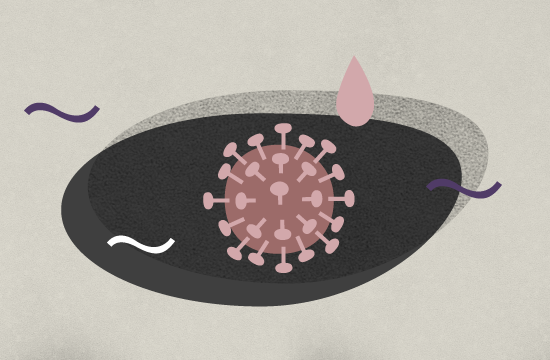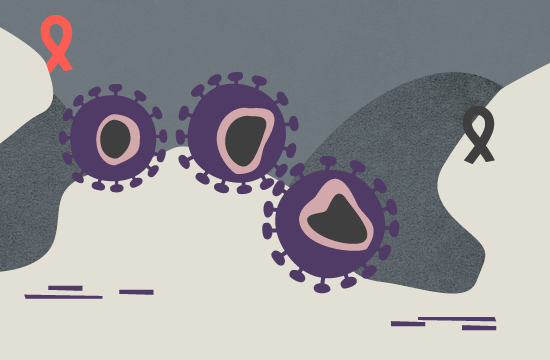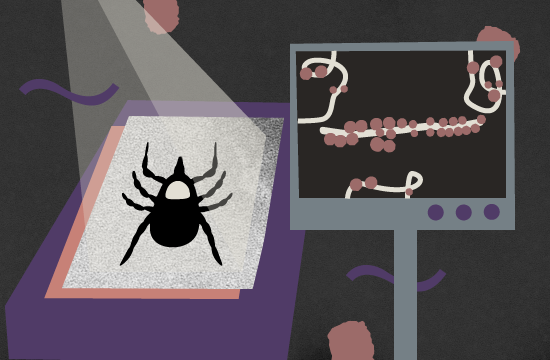Zoonoses – Pandemics
VIRUSES:
THE INVISIBLE DANGER FROM THE WILDS
Monkeypox, COVID-19, Ebola: viruses that jump from animals to humans can cause pandemics. LMU scientists are studying the tricks of the pathogens and developing suitable vaccines.
1/6
How the coronavirus pandemic began
Flashback: the first coronavirus patient in Germany
On the morning of 27 January 2020, the phone rings in the Division of Infectious Diseases and Tropical Medicine at LMU University Hospital Munich. The caller says he has mild cold symptoms. In ordinary circumstances, a blocked nose in winter would scarcely be worth mentioning, never mind making a call to an institution specialized in tropical diseases. However, a few weeks previously a new viral disease had emerged in the Chinese city of Wuhan. Resembling a traditional cold at the onset, the disease could end in severe inflammation of the lungs and death. Could the caller be the first case in Germany? The staff think this is unlikely but invite him in anyway. Not taking any risks is the policy.
The events of that day read like something out of a movie script. Because the episode was so important for the initial assessment and course of the coronavirus pandemic, LMU researcher Dr. Camilla Rothe, who heads the outpatient department at the Division of Infectious Diseases and Tropical Medicine, has told the story many times. Experts know that similar scenes will play out in the future – it is just a matter of time before another virus causes the next pandemic.
“At the time, people thought the outbreak was restricted to China,” recalls Rothe, who examined and interviewed the first patient herself. “The man had not even been to China,” she recounts. Rather, he had had contact with a Chinese colleague who did not have any symptoms. “From SARS-CoV-1 in 2002, we knew that infected people are only infectious if they also have symptoms,” says Rothe. And it was assumed that it would be the same for this new coronavirus. So Rothe and her colleagues were stunned when the test result came back positive.
Alarm bells started to ring in my head immediately,
remembers Rothe – and not because the first German coronavirus patient had been found, but because he had caught the virus from somebody who had no symptoms. “How do you quarantine a person who does not feel ill?” explains Rothe. “It was clear that we would be having a hard time containing a virus that behaves like that.”

Dr. med. Camilla Rothe
Head of outpatient department at the Division of Infectious Diseases and Tropical Medicine at LMU University Hospital Munich
Camilla Rothe is considered as discoverer of the first coronavirus case in Germany. Together with her team, she swiftly communicated her assumption that an asymptomatic COVID-19 infection was possible. Initially, she was heavily criticized by parts of the scientific community but in the end her hypothesis was proven right. In all likelihood, her decision to quickly go public saved a lot of lives. For her research achievements, Time Magazine included Rothe in its list of the 100 most influential people of 2020. And in September 2022, she received the Order of Merit of the Federal Republic of Germany.
Why zoonoses are becoming more frequent
Exotic pathogens are threatening people in the Global North
The pandemic probably began in December 2019 at a market in the Chinese city of Wuhan. According to experts, this is where a human most likely contracted the virus from a wild animal for the first time. In medical language, an infectious disease that originally comes from animals is called a zoonosis. From Wuhan, the virus spread around the world within months, as studies have demonstrated. The rest is history, as they say.
A concerning trend in recent times is the increasing frequency with which exotic pathogens from remote regions of the Global South have been threatening people in the Western world.
Since 1999, scarcely a year has gone by where we do not identify a major new outbreak event,
says Gerd Sutter, Professor of Virology at LMU’s Faculty of Veterinary Medicine. Sutter is an expert in emerging zoonotic pathogens and observes their global spread, partly in collaboration with the World Health Organization.

Prof. Dr. med. vet. Gerd Sutter
Gerd Sutter is Chair of Virology at the Institute for Infection Medicine and Zoonoses at LMU. He studied veterinary medicine at LMU, where he also obtained his doctorate. He went to the National Institutes of Health (NIH) at Bethesda, Maryland as a postdoc, before returning to LMU to complete his habilitation in virology. Having headed a research group in the Institute for Molecular Virology at Helmholtz Munich and the department of virology at the Paul Ehrlich Institute in Langen, Sutter accepted an invitation to join the staff at LMU in 2009.
Editor’s note: Professor Gerd Sutter passed away in October 2023
Gerd Sutter is in demand at various international institutions as an expert in poxviruses and vaccines, including the European Commission, the NIH, and the WHO. As a senior scientist at the German Center for Infection Research (DZIF), his work focuses particularly on the development of vaccines against infectious diseases that are transmitted from animals to humans. For his actions during the COVID-19 pandemic, Gerd Sutter was awarded an honorary doctorate by the University of Veterinary Medicine Hannover, together with Professor Christian Drosten and Professor Lothar Wieler.
Pathogens are constantly trying to cross species boundaries
“Pathogens crossing from animals to humans is in itself nothing unusual,” says Gerd Sutter. “There have always been zoonoses. Our ancestors knew that getting too close to animals could bring ill fortune – even if they knew nothing about pathogens.”
Professor Oliver T. Keppler, Chair of Virology at LMU’s Max von Pettenkofer Institute, agrees:
Pathogens are constantly trying to cross from one species to another.
Keppler studies the interactions of viruses with their hosts, with a special interest in HIV. “This zoonotic transmission usually fails, however, because there are specific hurdles for the spread of viruses in every species.” Put simply, the pathogen is not sufficiently adapted to the new host. And even if transmission to a human is successful, the infection generally dies out, because the pathogen is not transmitted any further. So it is a dead end for the virus in most cases.
But: “In rare cases, the pathogen does actually manage to adapt to the new host and to become a serious infectious disease for humans,” explains Keppler. This is the moment at which an epidemic or even pandemic can arise. Mostly, these are viral diseases and frequently – like coronaviruses – they can be transmitted through the air. A high mutation rate also helps viruses adapt quickly to the new host. In this way, they sometimes manage to get round the host’s antiviral immune defenses. Experts refer to this strategy as immune evasion. “The ability to quickly mutate can also help viruses become resistant to drugs,” adds Keppler.

Prof. Dr. med. Oliver Keppler
Oliver T. Keppler is Chair of Virology and Director of the Max von Pettenkofer Institute. He is also principal investigator at the Gene Center Munich. Keppler studied human medicine, initially in Freiburg im Breisgau and then at Heidelberg University, where he also completed his doctoral studies. After clinical posts in the domain of internal medicine in Switzerland, he obtained his medical license.
After that, Keppler had research stints at the German Cancer Research Center (DKFZ) in Heidelberg and the Gladstone Institute of Virology and Immunology at University of California San Francisco. From 2002 to 2012, Keppler worked at the Department of Infectiology at Heidelberg University Hospital, where he completed his habilitation in 2005. In 2009, he was appointed adjunct professor at Heidelberg University. In the same year, he was appointed consultant physician for microbiology, virology, and infection epidemiology. From 2012 to 2015, Keppler was director of the Institute of Medical Virology at Frankfurt University Hospital and full professor at Goethe University Frankfurt, before he took up the invitation to join the LMU staff in 2015. He is director of the German National Reference Center for Retroviruses and a researcher at the German Center for Infection Research (DZIF). In his research, he studies retroviruses and SARS-CoV-2 in relation to topics such as pathogenesis, test development, and possible therapies. For his role in helping to manage the coronavirus pandemic, Oliver Keppler was awarded the Bavarian Order of Merit.
Briefly explained
How viral zoonoses arise
Humans are encroaching on natural habitats
Regions in Asia, Africa, and Latin America, in particular, are main starting points for infection events. “In these places, contact between people and wild animals is becoming increasingly frequent – particularly in regions with strong population growth,” says Professor Michael Hoelscher, Director of the Division of Infectious Diseases and Tropical Medicine. The specialist in tropical medicine researches various infectious and tropical diseases, develops diagnostic techniques, and collaborates with researchers in partner countries in the Global South.
In such regions – Wuhan is a prominent example – people use every source of protein they can access, meaning that meat from exotic animals often ends up on their plates. Moreover, global population growth is causing people to settle new areas and create new agricultural land by means such as jungle clearances. “Of course, this removes natural barriers to wild animals,” says Hoelscher.
The same happens when big corporations – often with the participation or under the leadership of Western actors – mine natural resources or create huge plantations or cattle farms in these locations, for which massive tracts of woodland are cleared. This unhappy state of affairs is driven by the excessive consumption behavior of the Global North.
Naturally, zoonotic transmissions happen in Europe as well,
notes Hoelscher. The Borna disease virus, for instance, circulates in shrews in this part of the world and can cause encephalitis in humans. In both 2019 and 2022, a child died in Bavaria from an infection with this virus. However, our contacts with pets and livestock tend to be less problematic: “We’ve been living with domesticated animals for tens of thousands of years, and the transmissions took place at an earlier time.” This means that the human immune system has already learned to deal with these pathogens. If viruses from exotic wild animals arrive here, however, they can spread among domestic livestock. This caused the coronavirus outbreak in European mink farms, for instance.
In addition to the increased number of contact points between humans and wild animals, global warming is also facilitating the emergence of zoonoses. Changing climatic conditions can prompt so-called vectors – that is, transmitters of infectious diseases – to seek out new habitats. This includes the tick that spreads the Crimean-Congo hemorrhagic fever, which has increasingly been found over here in recent years. For virologist Gerd Sutter, one reason stands out in particular: the mobility of people. Once pathogens manage the leap to humans, they can sometimes spread rapidly around the world thanks to global connectivity and high levels of trade and foreign travel.

Prof. Dr. med. Michael Hoelscher
Michael Hoelscher is Director of the Division of Infectious Diseases and Tropical Medicine at LMU University Hospital Munich. He studied medicine at LMU and obtained his doctorate in 1996 at the division he leads today. His time at LMU was interrupted by several study and research stints to learn about infectious and tropical diseases at other institutions (such as the Walter Reed Army Institute of Research). Mbeya Referral Hospital in Tanzania became his second home. This was where he not only completed part of his infectiology training, but was also instrumental in establishing one of the largest research institutions in Africa, the Mbeya Medical Research Center.
Since 2010, Hoelscher has been DZIF Professor of Global Health & Infectious Diseases at University of Munich Hospital. In addition, he is a researcher and location spokesperson at the German Center for Infection Research (DZIF, coordinator for tuberculosis) and scientific lead of the consortium UNITE4TB, which is dedicated to the fight against tuberculosis. Michael Hoelscher conducts research into various infectious and tropical diseases, carries out clinical studies, develops diagnostic techniques, and collaborates with researchers in partner countries in the Global South, where he also works to improve health care. For his contributions to managing the coronavirus pandemic, Michael Hoelscher was awarded the Bavarian Order of Merit. Since 2022, he also heads the newly founded Fraunhofer ITMP (Fraunhofer Institute for Translational Medicine and Pharmacology) office for immunology, infection, and pandemic research (IIP) in Munich/Penzberg.
The dynamics of epidemics
Viruses conquer the world
At a crawl or at great speed, in small waves or like a tsunami, in people or in mosquitoes – viruses can conquer the world in very different ways.
HIV probably crossed over from monkeys to humans on repeated occasions without spreading any further. It was not until the beginning of the 1980s that an epidemic arose, which has continued to this day, especially in parts of Africa, and has claimed well over 35 million lives.
Some pathogens spread around the planet with the help of vectors. In the 1980s and 1990s, for example, the Aedes mosquito, whose bite can transmit dengue fever, traveled around the world on ships transporting used car tires. Little pools of water can gather in such tires, giving the mosquitoes somewhere to lay their eggs. The West Nile virus traveled in greater comfort in 1999, hitching a ride with a mosquito on a flight to New York. Soon there were the first infected birds in the metropolitan area, and within a few years the pathogen had spread throughout the American continent.
Since then, there have been outbreaks of bird and swine flu in Europe. And the worst Ebola fever outbreak to date ravaged West Africa in 2014 and 2015. The epidemic caused the death of more than 11,000 people – around 40 percent of those infected. There were also individual cases in Europe. As recently as the fall of 2022, a further outbreak in Uganda claimed lives.
1/4
MERS coronavirus infections Saudi Arabia
Particularly in Saudi Arabia, MERS-related coronavirus infections in humans have been a recurring problem since 2012. The spread of the virus is still limited and the symptoms are generally mild, although infection can be deadly for people with preexisting conditions.
2/4
SARS-CoV-2 (coronavirus)
Meanwhile, the SARS-CoV-2 virus spread throughout the planet within just a few months of its first appearance at the end of 2019. Almost seven million people have now died from the coronavirus, although some experts reckon the tally is actually much higher.
3/4
Lassa
In early 2022, the United Kingdom reported three cases of Lassa fever, each with a fatal outcome. The Lassa virus is endemic in West Africa; according to estimates, there are up to 300,000 infections annually.
4/4
Monkeypox/mpox
Since May 2022, monkeypox has been spreading in various countries outside Africa, including Germany. Experts were surprised at the infection numbers, as the disease is much less contagious than COVID-19, for example.
Question
What makes zoonoses elsewhere dangerous for us, Ms. Rothe?
Pathogens without borders
Viral zoonoses are spreading rapidly around the globe.
The world map shows outbreaks of selected zoonoses over the past few decades. It displays the zoonoses in their country of outbreak along with the year and animal reservoir. In each instance, the date refers to the first documented case of the virus in a human to date.
Sources: World Health Organization, Robert Koch Institute, Frontiers Media, Bavarian State Office for Health and Food Safety, European Centre for Disease Prevention and Control, National Library of Medicine, Science Magazine, Nature
Dangerous outbreaks growing more frequent
The frequency of exotic viruses that jump from animals to humans is increasing, posing a growing threat to people worldwide. The illustration shows outbreaks of zoonoses in the recent past.
Sources: Bavarian State Office for Health and Food Safety, European Centre for Disease Prevention and Control, National Library of Medicine, Robert Koch Institute, Science Magazine, World Health Organization
Outsmarting the pathogens
Vaccines are the best means of containing a pandemic. This was demonstrated long before the coronavirus crisis. Humans were literally plagued by smallpox for millennia, for example, and it was not until a vaccine was created – the first one ever developed, incidentally – that the disease was eradicated. That being said, it is extremely difficult to quickly design an effective and safe vaccine when a new pathogen appears.
For COVID-19, the vaccines were developed faster than ever before. This was partly due to the new mRNA technology, which had been intensively researched for several years before the coronavirus pandemic. But it was also due to the nature of the virus itself, whereby just one feature, the spike protein, was sufficient to generate immunity in the body.
Frequently, however, this is not so:
Many viruses have a complex biology, structure, and life cycle,
explains Sutter. In these cases, a single viral protein cannot achieve much as a vaccine. Instead, vaccines are required that present the body with a combination of different pathogen characteristics.
To this end, Sutter and colleagues use a vector vaccine platform based on Modified Vaccinia Ankara (MVA), an attenuated strain of the vaccinia virus which was developed at LMU 30 years ago. Using genetic engineering techniques, up to ten different antigens can be added simultaneously to the MVA. In this way, the researchers plan to develop vaccines in future against various model pathogens, which can be quickly adapted in emergencies.
This could even pave the way for brand new prevention strategies. Sutter’s team developed a vaccine against the MERS-related coronavirus, for example, which allowed the animal vectors of the pathogen on the Arabian Peninsula – dromedary camels – to be immunized. “The vaccine was able to significantly reduce the viral load in the animals,” explains Sutter, and thus reduce the risk of infection for humans.
Question
As regards possible new epidemics, what are the crucial factors, Mr. Sutter?
Oliver Keppler strives meanwhile to better understand the tricks of pathogens and their malign activities in the body. This is a prerequisite for developing drugs and suitable therapies. However, viruses are not exactly easy to figure out: “In most cases, you can’t just say: If this gene is there, then the virus is dangerous; and if not, then not,” cautions Keppler. With viruses, therefore, understanding basic principles is often the key: “Which disease-causing mechanisms or replication advantages are there which we can combat?”
Keppler and his team ask themselves this question in relation to HIV in particular. “In the course of its evolution, this virus has managed to form proteins that can weaken our innate immunity,” explains Keppler. He and his colleagues therefore want to find out, among other things, how this particular part of our immune defenses can be bolstered in its fight against HIV. Research findings into the basic immunological principles of the virus-host interaction can ultimately be applied also to other infectious diseases – helping us be better prepared against new pathogens.
Question
What can we learn from the coronavirus pandemic, Mr. Keppler?
Watching out for dangerous pathogens
Profiles of five viruses that have their origin in the animal kingdom
Experts are certain: the next pandemic is coming. And to give themselves a head start in the race against infection when an emergency arises, they have their eye on potentially dangerous candidates.
SARS-CoV-2

ORIGIN
Although it has still not been definitively established where the virus originated, many signs indicate that it came from a bat reservoir in China. The pathogen possibly leaped to another animal, which then infected the first human.
TRANSMISSION
Transmission occurs mainly via virus particles in the air, which infected people emit when breathing, coughing, sneezing, and speaking. This makes the likelihood of infection in confined spaces high, while, conversely, wearing masks and ventilating rooms help prevent infection. Unlike with SARS-CoV-1 and MERS-CoV, other members of the coronavirus family, people without symptoms are also contagious.
SYMPTOMS
SARS-CoV-2 usually causes an infection of the respiratory system with coughing, fever, runny nose, and/or loss of smell and taste. However, the course taken by the disease varies greatly, ranging from asymptomatic infections to lung failure resulting in death. After-effects include shortness of breath and memory and concentration disorders.
DISTRIBUTION
As the virus is highly contagious, the disease spread so fast from the first infected people in Wuhan, China, in December 2019 that it caused a global pandemic within months. Containment was difficult to impossible, because even asymptomatic carriers are contagious. Infection numbers have since fallen, although experts still expect limited local outbreaks.
POTENTIAL DANGER
Because there was no general immunity in the population, many people became very ill – with elderly and immunocompromised patients hit particularly hard. Through several mutations of the virus, the disease became milder. In addition, many people have now built up a certain immunity as a result of infection and/or vaccination. The emergence of more dangerous variants in the future cannot, however, be ruled out.
VACCINES
In Germany, we have been vaccinating people against the novel coronavirus since 26 December 2020. There are now four vaccines available, which were developed at unprecedented speed. Two of them – the vaccines from BioNTech/Pfizer and Moderna – are based on the new mRNA technology, a genetic method that enables the vaccine to be adapted with relative quickness to new variants. The technology is helped in this case by the fact that a main feature of the virus, the spike protein, is sufficient to train the immune system. Further vaccine candidates are in the development or approval process.
Monkeypox/mpox:

ORIGIN
Monkeypox viruses are common in rodents in West and Central Africa. The disease caused by the viruses was observed for the first time in 1958 in laboratory monkeys, which had pox-like symptoms – hence the name monkeypox. The first human case to be established was in a baby in the Democratic Republic of the Congo in 1970. Now the World Health Organization refers to the disease by the name of “mpox.”
TRANSMISSION
Infection occurs through direct contact of skin or mucous membranes with body fluids. The portals of entry are generally small wounds. In particular, the typical skin changes in infected people – the so-called pox lesions – contain large amounts of the virus. Such lesions also occur on mucous membranes and are often not visible from the outside.
SYMPTOMS
Characteristic symptoms include changes to the skin, which can be very painful. These start out as a rash and turn into pustules before finally developing a crust and falling off. Frequently, patients also have general symptoms of illness such as fever, headaches, muscular pain, and backache. Compared to smallpox, however, the disease takes a much milder course.
DISTRIBUTION
After the first human case in 1970, infections were most commonly observed in West and Central African countries. In the spring of 2003, monkeypox was diagnosed in a human in the United States, the first such case outside the African continent. The virus had probably entered the country with rodents from Ghana. Since then, there were only isolated cases until the spring of 2022, when a worldwide wave of infections began, including in Germany.
POTENTIAL DANGER
There are drugs against monkeypox, and even untreated the disease is rarely fatal. Moreover, it is relatively easy to break infection chains, as infected people have obvious symptoms and the virus is transmitted only through close bodily contact.
VACCINES
A smallpox vaccine has been approved in the European Union since 2013. Marketed under the trade name Imvanex, it also protects against monkeypox. The vaccine is based on the non-reproductive MVA vaccinia virus, which is also used at LMU for research into highly versatile vaccine platforms. Because it is a DNA virus, it mutates much less than the RNA viruses from the coronavirus or influenza families, for example, and so the vaccine has long-term effectiveness.
Ebola

ORIGIN
Experts suspect that bats are the natural reservoir of the virus. There are many indications, for example, that the large outbreak in West Africa in 2014/2015 originated with the Angolan free-tailed bat (Mops condylurus). The transfer from animals to humans results from contact with infectious animal products, such as when people go hunting and eat their kill.
TRANSMISSION
Infection occurs via the blood, saliva, sweat, urine, stool, or vomit of Ebola patients. As such, people generally only become infected through direct contact with these fluids. However, the viruses also survive for a period of time on objects that have come into contact with infectious fluids – such as surgical instruments, clothing, and bedclothes.
SYMPTOMS
At the beginning, the symptoms resemble a flu infection: fever, limb pain, and tiredness. After a few days, the patient can additionally experience stomachache, nausea, vomiting, diarrhea, and bleeding. Some patients have a wide variety of other complaints over the course of their illness. In some cases, convalescents suffer from post-Ebola syndrome with muscle and joint pain and further symptoms.
DISTRIBUTION
After the discovery of the first Ebola case in 1976, there have been repeated local outbreaks in Central Africa. The largest wave of infections in 2014 and 2015 was centered on the West African countries of Guinea, Sierra Leone, and Liberia. In the meantime, however, there have also been isolated cases in the United States and Europe.
POTENTIAL DANGER
The disease is often fatal, making the virus one of the most dangerous in the world. Further outbreaks are to be expected, especially as people encroach ever further on the habitats of wild animals. On the positive side, it is relatively easy to break chains of infection, as only infected people with symptoms are generally contagious.
VACCINES
The live vaccine ERVEBO has been approved, for example, in the European Union, the United States, and some African countries since 2019. It is injected once into a muscle. In vaccine studies, ERVEBO has already been tested on the contacts of diagnosed cases at the end of the 2014/2015 outbreak. The provisional, estimated vaccine efficacy is almost 100 percent a few days after the dose is administered. It is not known, however, how long the protective effect lasts. An Ebola outbreak in Sudan in September 2022 was caused by a strain of the virus for which there is not yet a vaccine.
HIV

ORIGIN
HIV originated in chimpanzees and gorillas. The oldest human blood sample in which the virus was detected came from the Congo in 1959. Experts assume, however, that the disease was already long present in Africa and that transmissions from animals to humans had happened on multiple previous occasions.
TRANSMISSION
The virus is transmitted by body fluids – blood, semen, vaginal secretion, breast milk. Possible portals of entry include fresh, still bleeding wounds and mucous membranes. The most common infection route is unprotected sex. Contaminated needles, as shared by drug addicts for instance, are another common route of infection.
SYMPTOMS
HIV stands for human immunodeficiency virus. It got this name because the pathogen damages certain immune cells. This makes infected persons susceptible to diseases that healthy people can shake off. As such, AIDS symptoms tend to be unspecific complaints such as tiredness, joint pain, and loss of appetite. AIDS sufferers who go untreated die on average in about 10 to 12 years – mostly not from AIDS itself, but from comorbidities.
DISTRIBUTION
In reconstructions, researchers have determined that HIV occurred sporadically outside of Africa by the end of the 1960s at the latest. But it was not until the 1980s that a major wave of infections occurred – with the United States as the hotspot initially. From there, the virus traveled around the globe. In 1982, the first cases in Germany were discovered. Today, there are almost 40 million people infected with HIV worldwide – more than two-thirds of whom live in Africa.
POTENTIAL DANGER
With prompt treatment, HIV usually does not progress to AIDS. Moreover, patients who receive regular treatment are almost completely non-contagious. Accordingly, the virus is particularly dangerous in places where health care is poor. This applies above all to poorer regions of Sub-Saharan Africa, where the fight against AIDS is far from over. It is estimated that 37 million people worldwide have died from AIDS since the start of the pandemic.
VACCINES
Since the 1980s, scientists have been searching for a vaccine – without success. One reason is that the virus, which comes from the family of retroviruses, mutates at an amazingly fast rate: In the body of a HIV-positive person, more different virus variants emerge every day than flu variants worldwide in a year. The docking sites for antibodies, the production of which is stimulated by vaccines, are thus constantly changing. After just a few viral generations, the antibodies are ineffective.
Crimean-Congo hemorrhagic fever virus

ORIGIN
The virus circulates in domestic and wild animals such as cows, sheep, hares, and birds. In these creatures, infections are generally asymptomatic. The virus was first discovered in human blood in the Congo in 1956.
TRANSMISSION
The virus is usually transmitted by a so-called vector, in this case a tick. The tick gets the virus from infected animals and passes it on to humans by means of bites. Transmission can also take place through contact with the infectious blood or body fluids of animals. Human-to-human transmission is rare, but smear and droplet infections cannot be ruled out.
SYMPTOMS
The infection starts with unspecific symptoms such as fever, shivers, headaches, and joint pain. As the disease progresses, people often have gastrointestinal problems with vomiting and muscle pain. In the so-called hemorrhagic phase, which begins after around four days, there is bleeding in various organs. This frequently leads to death from multiple organ failure.
DISTRIBUTION
The pathogen is common primarily in warmer regions – including the entire Mediterranean region, parts of Eastern Europe, and regions of Africa and Central Asia. These are places where the tick that is chiefly responsible for passing the virus between hosts is endemic. Imported infections have been recorded in Germany only in very rare cases.
POTENTIAL DANGER
The fatality rate is between 10 and 40 percent. People living in regions where the virus is endemic are most at risk, as they have more contact with ticks and other host animals. However, the tick is spreading to new habitats as a result of climate change, which could lead to more cases in Germany in the future.
VACCINES
To date, no vaccine or effective treatment exist. But scientists are exploring possible therapies.
Can pandemics be avoided?

What we can learn from previous epidemics
Even in the future, it will not be possible to prevent epidemics and pandemics – this is something on which all four of our interviewed LMU experts agree. Importantly, however, the global community can prepare for such events, both at the national and the international level. What we need is a sensible “mix of prevention, diagnosis, and therapy,” says Oliver Keppler. At the national level, this calls for infrastructure that permits a rapid response to the emergence of an infectious disease. As well as the availability of modern testing and analysis facilities, this requires a robust health system. In addition, the supply of personal protective equipment and drugs must be ensured, ideally by national production and supply chains. “I hope that the coronavirus pandemic was a lesson to us in this regard,” says Sutter.
Honest, easy-to-understand communication strategies are important to earn public acceptance for the containment measures. Only then will people observe hygiene and other prevention rules, such as testing and self-isolating in the case of suspected infection. Furthermore, we need tools and facilities to monitor infections with new pathogens as well as known ones – both inside our countries and outside:
We scour various networks every day for information about new emerging diseases, or about known diseases sprouting up in unusually high numbers,
says Camilla Rothe from the Division of Infectious Diseases and Tropical Medicine.
But monitoring is effective only if the global community works together. For this reason, specialist in tropical diseases Michael Hoelscher advocates for stronger international cooperation and the building of trust, so that knowledge is quickly and transparently communicated in future. “In emergency situations, every day counts,” he warns. The countries in which the pathogens often arise generally lack the resources and infrastructure needed to contain epidemics. “If we want to prevent pandemics, we have to support these countries,” recommends Hoelscher. This can be achieved, for example, by strengthening local health care systems. And so is clever design, such as the diagnostic techniques that LMU researchers are developing specifically so that they can be easily implemented in poorer countries.
But before the urgent measures required can actually be put into practice, there needs to be an awareness of the danger. “Usually, people in these places have more immediate problems than to be worrying about epidemics,” says Hoelscher. This is where education can help – such as the planned initiative by LMU and others to set up special master’s and doctorate programs in African countries for the purpose of educating the next generation of scientists. “We want to have cooperation partners that can carry out their own research projects in their own country,” explains Hoelscher. Scientific expertise on site also facilitates future cooperation.
Question
Why are zoonoses not combated in the place where they arise, Mr. Hoelscher?
This mix of local and global measures strengthens our defenses against impending epidemics and pandemics. But they do not address the root cause. It is the consumption-intensive lifestyle of rich industrial nations at the expense of nature that is hurting our planet and driving the occurrence of zoonoses. We get daily reminders that this cannot turn out well in the long run: floods, droughts, hurricanes, species extinction – and pandemics. These are all symptoms of a sick planet. The overriding question, then, when it comes to our management of dangerous pathogens and the avoidance of pandemics, is therefore: How do we make the Earth healthy again? The search for answers begins with the lifestyle of each individual person.
Address
80539 München
Phone: +49 89 2180-0
Fax: +49 89 2180-2322
Sites

